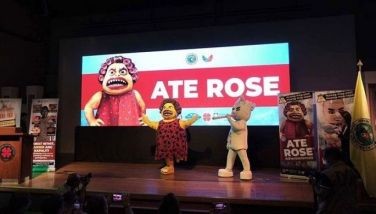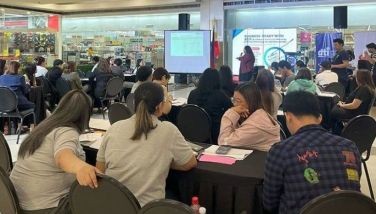Another Legazpi show
June 23, 2004 | 12:00am
To mark Legazpi’s fifth birth centennial, San Agustin Museum director Fr. Pedro Galende, the Spanish Embassy, the Manila Mayor, the NCCA and the Tourism Department will open the exhibit Enduring Friendship – Amistad Duradera tonight at six at the San Agustin Church where Legazpi is buried.
Only last month, the exhibit From Legazpi to Malaspina was mounted at the National Museum by Javier Galvan of the Instituto Cervantes and Corazon Alvina, Museum director. Shown were paintings, relics, armory, books, documents, a baul containing a map of Manila and other precious items dating back to Legazpi’s time.
Relative to the passage of Senate Bill 9187 proclaiming every June 30 Fil-Spanish Friendship Day, the San Agustin Church exhibit highlights the tremendous religious, economic, political and cultural presence of Spain in the Philippines during the colonial era to further fortify Fil-Spanish bonds.
In the Sala de Capitulacion of the church, history – divided into evangelization, government, agriculture and education under Spain – comes alive through maps, photos, illustrations and art pieces. Fr. Galende has summarized the substance and meaning of the exhibit but space limitations allow for only excerpts on the education section titled "God-centered humanism, language, literature and art".
The Filipinos excelled in fine arts, with Nick Joaquin noting that even if "painting was not one of our pre-Hispanic arts, and can, therefore, be regarded as the most foreign to our nature, it was in this that the Filipinos have most excelled."
Before the 19th century, Filipino art was mostly religious, manifesting itself in images and paintings to decorate churches, convents and homes. Secular art was initiated in the late 18th century in the form of Letras y Figuras by persons in the ecclesiastical field.
Damian Domingo shone in the Escuela de Dibujo founded in 1820 from where many great Filipino partners graduated, several of whom were sent to Spain as scholars.
Jose Honorato Lozano made a great impact with his Letras Y Figuras which recorded scenes of Philippine life. He was followed by Juan Arceo and his son Isidro, Damian Domingo, "Prince of Philippine painters", Juan Luna, Felix Resurrecion Hidalgo and artists who contributed to Flora de Filipinas (1884) like Cayetano Arguelles, Francisco Domingo, the Garcia brothers, Lorenzo Guerrero, Hidalgo, etc.
The Filipinos also excelled in music, dance, basketry, beadwork, textiles and embroidery, gold jewelry, silver smithing, wood and ivory carving and engraving. Theater became popular as awits and corridos were staged in church patios and town plazas. An early playwright, Jose de la Cruz, a.k.a Husing Sisiw, was followed by Francisco Baltazar or "Balagtas."
The cantorals or music books of San Agustin (Intramuros) and Baclayon (Bohol) are samples of early church music and works of art portraying miniaturist illustrations. A special mention is made of silversmiths, goldsmiths and sculptors of images, the santos being a unique sample of the Filipino’s mastery of sculpting.
Only last month, the exhibit From Legazpi to Malaspina was mounted at the National Museum by Javier Galvan of the Instituto Cervantes and Corazon Alvina, Museum director. Shown were paintings, relics, armory, books, documents, a baul containing a map of Manila and other precious items dating back to Legazpi’s time.
Relative to the passage of Senate Bill 9187 proclaiming every June 30 Fil-Spanish Friendship Day, the San Agustin Church exhibit highlights the tremendous religious, economic, political and cultural presence of Spain in the Philippines during the colonial era to further fortify Fil-Spanish bonds.
In the Sala de Capitulacion of the church, history – divided into evangelization, government, agriculture and education under Spain – comes alive through maps, photos, illustrations and art pieces. Fr. Galende has summarized the substance and meaning of the exhibit but space limitations allow for only excerpts on the education section titled "God-centered humanism, language, literature and art".
The Filipinos excelled in fine arts, with Nick Joaquin noting that even if "painting was not one of our pre-Hispanic arts, and can, therefore, be regarded as the most foreign to our nature, it was in this that the Filipinos have most excelled."
Before the 19th century, Filipino art was mostly religious, manifesting itself in images and paintings to decorate churches, convents and homes. Secular art was initiated in the late 18th century in the form of Letras y Figuras by persons in the ecclesiastical field.
Damian Domingo shone in the Escuela de Dibujo founded in 1820 from where many great Filipino partners graduated, several of whom were sent to Spain as scholars.
Jose Honorato Lozano made a great impact with his Letras Y Figuras which recorded scenes of Philippine life. He was followed by Juan Arceo and his son Isidro, Damian Domingo, "Prince of Philippine painters", Juan Luna, Felix Resurrecion Hidalgo and artists who contributed to Flora de Filipinas (1884) like Cayetano Arguelles, Francisco Domingo, the Garcia brothers, Lorenzo Guerrero, Hidalgo, etc.
The Filipinos also excelled in music, dance, basketry, beadwork, textiles and embroidery, gold jewelry, silver smithing, wood and ivory carving and engraving. Theater became popular as awits and corridos were staged in church patios and town plazas. An early playwright, Jose de la Cruz, a.k.a Husing Sisiw, was followed by Francisco Baltazar or "Balagtas."
The cantorals or music books of San Agustin (Intramuros) and Baclayon (Bohol) are samples of early church music and works of art portraying miniaturist illustrations. A special mention is made of silversmiths, goldsmiths and sculptors of images, the santos being a unique sample of the Filipino’s mastery of sculpting.
BrandSpace Articles
<
>
- Latest
- Trending
Trending
Latest
Trending
Latest
Recommended
























